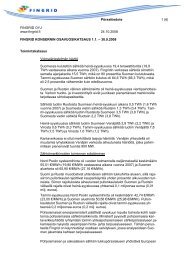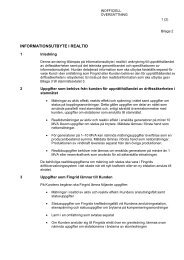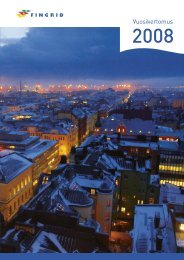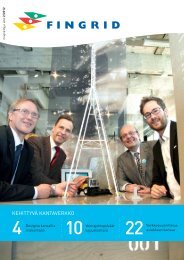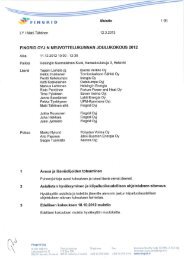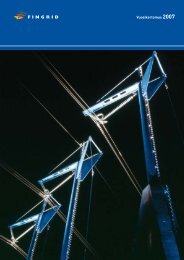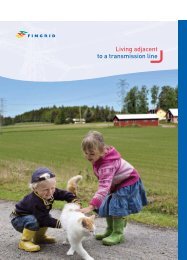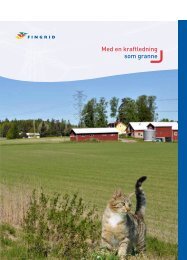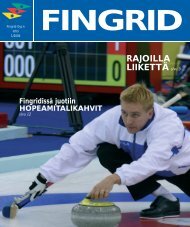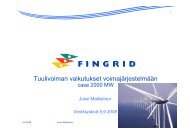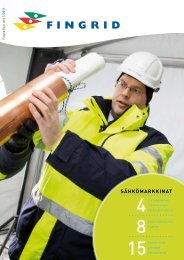Evolving transmission grid Field tower – economical ... - Fingrid
Evolving transmission grid Field tower – economical ... - Fingrid
Evolving transmission grid Field tower – economical ... - Fingrid
- No tags were found...
Create successful ePaper yourself
Turn your PDF publications into a flip-book with our unique Google optimized e-Paper software.
<strong>Evolving</strong> <strong>transmission</strong> <strong>grid</strong><strong>Field</strong> <strong>tower</strong> <strong>–</strong> <strong>economical</strong> <strong>transmission</strong> of electricity
2The design of the field<strong>tower</strong> intends to render thearable landscape airy andhence reduce the landscapedrawbacks of an electricity<strong>transmission</strong> line.
12New <strong>tower</strong> for fieldsto facilitate cultivationFin<strong>grid</strong> has devised a new type of <strong>transmission</strong>line <strong>tower</strong>, which is based on landowners’ andfarmers’ needs and wishes.The <strong>tower</strong> referred to as a field <strong>tower</strong> makesmore arable land available for cultivation andfacilitates the tillage of soil. The most noticeabledifference between the traditional <strong>tower</strong> types andthe field <strong>tower</strong> is that the field <strong>tower</strong> has no guywires; the <strong>tower</strong> is self-supporting. When workingon the field, it is no longer necessary to go aroundthe guys and look out for them.3One <strong>tower</strong><strong>–</strong> two <strong>transmission</strong> linesIn a field <strong>tower</strong>, a 400 kilovolt <strong>transmission</strong> lineruns at the top and a 110 kilovolt line beneath it.There is a safety distance of 11 metres betweenthe conductors.The height of the <strong>tower</strong> is in the same range asthat of a conventional 400 kilovolt <strong>tower</strong>, where theupper crossarm is at a height of 31, 33 or 35 metres.The <strong>tower</strong> spacing is 300 to 450 metres.The field <strong>tower</strong>s are primarily used in the constructionof new <strong>transmission</strong> lines. They can alsobe erected on existing lines in conjunction with thereplacement of a line or some its <strong>tower</strong>s. The field<strong>tower</strong>s are made of galvanised steel. They can bepainted with a desired colour. The service life of the<strong>tower</strong>s is 80 to 100 years.
4The new field <strong>tower</strong>stands firmly on four legs,without guy wires whichimpede farming work.
Accessibilityand safetyAgricultural machinery can be operated morefreely near the new <strong>tower</strong> than in the vicinity ofconventional guyed <strong>tower</strong>s. The most commonharrows, plant protection equipment and combineharvesters can run under the <strong>tower</strong>, since the spaceunder the <strong>tower</strong> is 7 metres in the longitudinaldirection and 14 metres in the cross direction of the<strong>transmission</strong> line.Protective structures surrounding the legs of the<strong>tower</strong> prevent potential collisions with the legs. Inthis way, soil can be worked quite close to the <strong>tower</strong>.The lower structures of the new field <strong>tower</strong> aremuch more visible than the guys in the conventional<strong>tower</strong>s. This also reduces the risk of collisions whenoperating machines.5Since the new <strong>tower</strong>s have no guys, weedingproblems in the surroundings are also significantlyreduced.
6The structure and design ofthe field <strong>tower</strong> are devised towithstand decades of stress.The <strong>tower</strong>s must be designedto accommodate winds andother demanding weatherconditions; in the winter aconsiderable ice load mayaccumulate on the lines.
Strength of steelon a concrete baseThe field <strong>tower</strong> stands firmly on four legs. Thefoundations of the <strong>tower</strong> are composed of twoprefabricated concrete sections joined together.This stabilises the <strong>tower</strong> structure. Separateconcreting work is not required, but the entirefoundation is built as prefabricated constructions.Each part of the foundation weighs 3 tonnes.In other words, the four-legged <strong>tower</strong> is anchoredto the ground using concrete foundations of 24tonnes.The <strong>tower</strong> is fastened to the four pillar elementsby means of anchor bolts. The mountingto the foundations and the loading of the <strong>tower</strong>have been tested by the Tampere University ofTechnology. The <strong>tower</strong> with its base weighs almost40 tonnes. There are a total of 17 conductors onthe <strong>tower</strong>: 9 phase conductors in the 400 kilovoltline and 6 in the 110 kilovolt line. There also 2overhead ground wires. The heaviest of these isthe 400 kilovolt conductor, which weighs 2 kilosper metre.The material efficiency of the foundations andsteel structure is also an environmental asset. Thework stages related to the erection and maintenanceof the <strong>tower</strong>s have been minimised, and thegoal is to schedule them at times when they causeleast harm to the farmer.The functioning, durability andsafety of the field <strong>tower</strong> have beensecured through a variety of tests.The test assembly of the <strong>tower</strong>revealed that the details certainlyfit into place.Harmony of shapein the landscapeFin<strong>grid</strong> is an international trailblazer in combininghigh-quality industrial design and technicalconstructions. Special-design <strong>tower</strong>s intended forbuilt-up areas and delicate landscapes are prominentexamples of the company’s approach whichrespects the environment. The oldest of these socalledlandscape <strong>tower</strong>s date from the 1990s.The field <strong>tower</strong> carries on the same open-mindedapproach which has also attained internationalacclaim.The new <strong>tower</strong> is transparent and airy. It has alesser impact on the landscape than the traditionallattice design. This is of importance when thereare many <strong>tower</strong>s in an arable landscape.Fin<strong>grid</strong>’s partners in the design of the new<strong>tower</strong> type have comprised the design agencyMuotohiomo Oy, Empower Oy which specialises inconsulting services in the energy industry, and theconcrete producer Betroc Oy.7
Powering Finland.FINGRID OYJLäkkisepäntie 21, P.O. Box 530, FI-00101 Helsinki, Finland | Telephone +358 30 395 5000 | Fax +358 30 395 5196 | www.fin<strong>grid</strong>.fi



